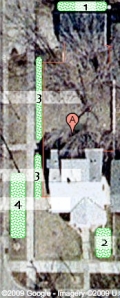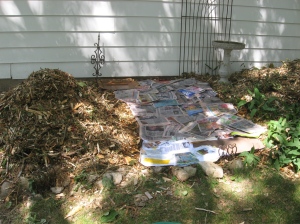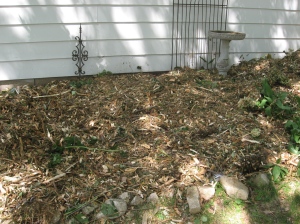Wow, I see that it’s been over a month since I last posted. That doesn’t mean we haven’t been busy, busy, busy in the gardens.
First of all, the alley. Oh, how it has changed. We have covered the entire 31′ x 7′ strip with cardboard to smother the grass and added layers of leaves and organic waste matter from my SIL’s floral business, which is conveniently located two houses away. It’s a win-win because she has avoided surcharges on her garbage bill and I don’t have to haul the stuff in or pay for it. Some patches of this still need more organic material, but we have plenty of leaves so it shouldn’t be an issue. Then on top we have placed burlap sacks with the hope that they will assist in preserving the moisture needed for the organic materials to break down. While they will help keep the moisture in, they will also LET more moisture in, something black plastic wouldn’t have been able to do (we also considered this).
My hangup with the alley is: once all this beautiful material has decomposed and we are establishing perennials in it, will it get washed away? Do we need to do some kind of edging or ground cover to keep it in place? This is cheifly a concern down by the driveway. Ideas?

The sheet-mulched alley. Sheet-mulched because it has layers, or sheets, of organic material under the fabric, not because they happen to be bedsheets! 🙂
We have done a similar project in the front yard, but only with leaves, and I don’t think enough leaves. We plan to have a flagstone path installed in the path-y looking opening next year.

These new beds will get full sun for edibles and ornamentals.
I am currently researching if we should mulch some of our leaves and allow them to remain on the lawn. The unclear point is how many you can actually leave on and benefit rather than damage the lawn. I guess what I have to remember is that the backyard grass is pretty darn junky anyway, with a number of dead patches – and I mean, bare soil dead – so if I kill off a little grass, it won’t be a big deal. But clearly the preferred result would be healthier, greener grass. Our backyard is the epitome of the term “green concrete.” There is really nothing to that dirt. It’s packed and pathetic. Hopefully adding the leaf material would attract some beneficial organisms to the soil which would aerate, decompose the thatch, and make the grass grow even greener. But I don’t hold my breath that one batch of chopped up leaves will have that all happening next spring. Will keep researching. At any rate it is raining and we are going out of town for the weekend so we have a few days to develop the game plan.
Also still thinking about and learning what to do with the boulevard. Found a nice information sheet at the Union Park Council Website that has given me some food for thought design-wise. I think we’d have to remove some soil if we were going to create richer soil lasagna-style in the leftover space. And of course then you have to put it somewhere . . . so will continue to think about this over the winter.









